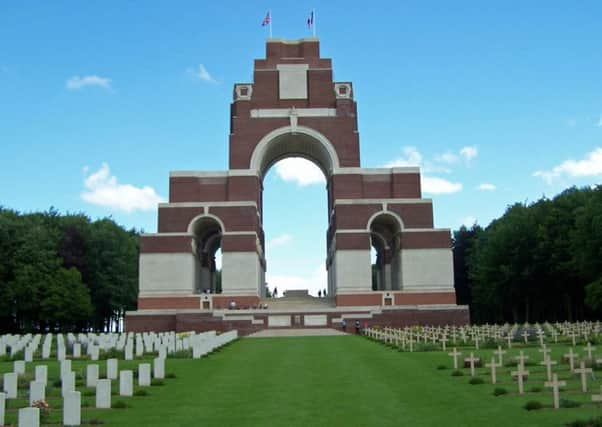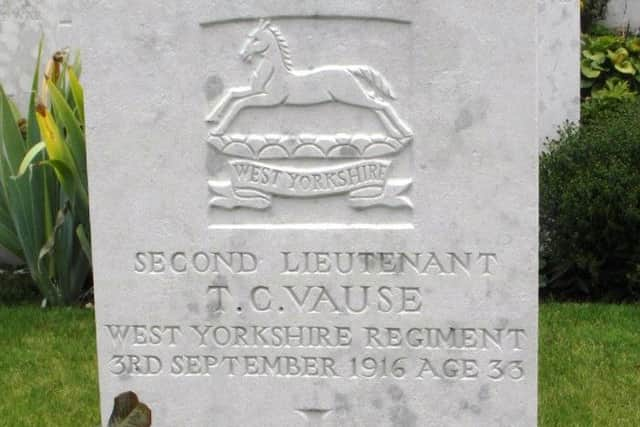NOSTALGIA: Tragic day when Spen's men fell at the Somme


The date, September 3, commemorated the day when, during the second phase of the World War One battle, several units containing Kirklees soldiers suffered heavy casualties.
The service at Whitechapel Church in Cleckheaton, which was led by the Rev Brunel Jones, told the stories of three men who were killed in action.
Advertisement
Hide AdAdvertisement
Hide AdCaptain Charles Hirst from the West Riding Regiment was just 22 when he died, and he has no known grave, although he is listed on the Thiepval Memorial. He was from Fieldhead and also lived in Cleckheaton before joining the army as a commissioned officer in 1912. The career soldier was posted to his home company, the Cleckheaton Territorials, before the war, and was regarded as having great promise and exceptional ability. When war broke out, he took his battalion to the Front and was promoted to captain in 1915, having previously been in charge of transport.


He died leading his company in the attack on the Schwaben Redoubt, a German stronghold just north of Thiepval village. He was one of many local men killed in this action, which became known in Cleckheaton as Bloody Sunday.
His fellow officer Major James Walker, in a letter to the family, said Charles was loved by all his brother officers and he personally had lost a great friend.
Charles Hirst was a member of one of Cleckheaton’s prominent families. His father owned Charles Hirst & Sons Exchange Wireworks and was the employer of many local men who served, some of whom were also killed. Educated at Bradford Grammar School and then in Germany and France where he studied languages, he was destined for a commercial career in the family business. His parents received many letters of consolation from fellow officers and it was the general opinion that Charles would have attained a very senior rank had he not been killed. He is also commemorated on the Cleckheaton Sports Club, Cleckheaton Conservative Club and Whitechapel Church war memorials.
Advertisement
Hide AdAdvertisement
Hide AdSecond Lieutenant Alfred Edison Hirst, of the same regiment, was 24 when he died and lived in Vine Cottage in Cleckheaton. He had also joined the reserves before the war, and served at Ypres before being sent to the Somme in 1916. The attack at 4am on Sunday September 3 on the Schwaben Redoubt is part of local folklore as so many locals in the 1st/4th Battalion lost their lives.


The Redoubt was a German fortress on a small hill, surrounded by strategically placed machine guns. Underneath was a series of tunnels containing sleeping accommodation, bakeries, a hospital and messes. ‘Eddie’ was killed while leading his platoon and a witness states that he saw him mortally wounded in a shell hole.
His body was never retrieved for burial, and he is commemorated on the Thiepval Memorial.
The family received many letters of sympathy from fellow officers who survived, including Major Walker and Captains Fenton and Mowat who all lost brothers in the conflict. His father, Eli Hirst, was the proprietor of the Spenborough Guardian, and he had many letters published describing life in khaki. He was educated at Batley and Bradford grammar schools and subsequently joined the business of A E Smith & Co at Pyenot Hall Wireworks, Cleckheaton, in a ‘responsible position’. He was well known and respected in the area and was prominent in local Scouting circles, being Master of the Moorbottom Troop in Cleckheaton. His name also appears on the war memorials at Whitechapel Church and St John’s Church.
Advertisement
Hide AdAdvertisement
Hide AdSecond Lieutenant Thomas Christopher Vause of the Leeds Rifles was 33 when he was killed. He lived in Netherfield, Cleckheaton with his young family, and he is buried in France. His battalion was involved in a large scale attack just north of Thiepval village. The objective was to capture a machine gun post known as the Pope’s Nose. However, on leaving Thiepval Wood, many casualties were sustained from the German machine guns situated in the Pope’s Nose and also on the Schwaben Redoubt overlooking the objective.
He was reported missing but it was not until August 1917 that the family received the telegram stating that he was ‘now presumed dead’. Many of the casualties from that attack were not found until spring 1917 following the German retreat to the Hindenberg Line.
Thomas was a native of Leeds and after leaving Leeds Boys’ Modern School he went to Cambridge University in 1904, and obtained a Master’s degree in 1911. He subsequently gained a law degree and embarked upon a teaching career.
He was appointed Second Master at Whitcliffe Mount Secondary School in Cleckheaton in 1914. A fine all-round sportsman as well as a brilliant academic, he was well-liked by both staff and pupils. He was the only son of Councillor and Mrs Vause of Moor Allerton, Leeds. Soon after he was reported missing, his wife and two small children returned to live with her family in Leeds.
Advertisement
Hide AdAdvertisement
Hide AdA second teacher at the school, Lance Corporal Evan Williams, who taught chemistry, was killed in July 1918. The pair had joined the school together in 1914 and were commemorated by having a school house named after them in 1932. Seven other former pupils and staff, Arthur Armytage, Percy Bentley, William E Brooke, John Butterfield, Reginald Drake, Percy Holdroyd and Tom Jowett, also died in service.
Spenborough branch chairman Eddie Morton said:
“The Royal British Legion is the custodian of remembrance and it is heartening to see local communities and churches remembering local men who served with distinction and in turn passing it on to the younger generation. We must try and maintain the support generated by the centenary of the war for the youth of today to take forward.”
Pictured are the Hirst Window in Whitechapel Church, Thomas Vause’s grave at Mill Road Cemetery, and the Thiepval Memorial to the missing.